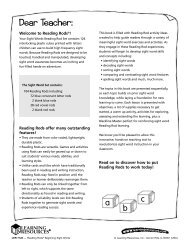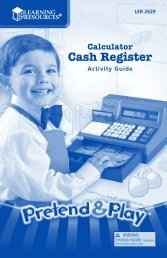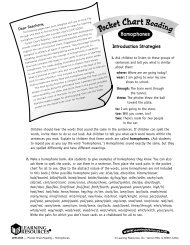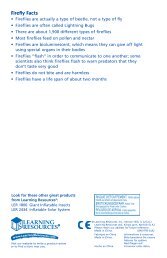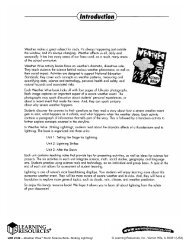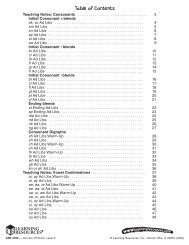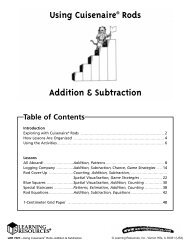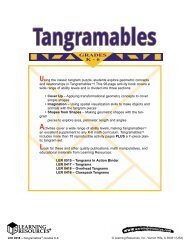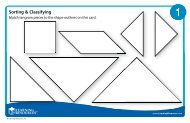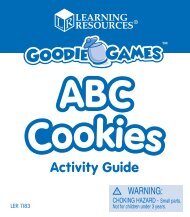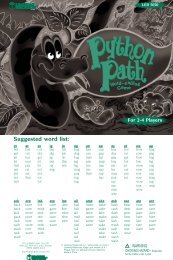Using Cuisenaire® Rods Fractions & Decimals - Learning Resources
Using Cuisenaire® Rods Fractions & Decimals - Learning Resources
Using Cuisenaire® Rods Fractions & Decimals - Learning Resources
Create successful ePaper yourself
Turn your PDF publications into a flip-book with our unique Google optimized e-Paper software.
<strong>Using</strong> Cuisenaire ® <strong>Rods</strong><strong>Fractions</strong> & <strong>Decimals</strong>Table of ContentsIntroductionExploring with Cuisenaire ® <strong>Rods</strong> 2How Lessons Are Organized 4<strong>Using</strong> the Activities 6LessonsPairing Off <strong>Fractions</strong>, Spatial Visualization,Equivalence, Ratio and Proportion 8Name That Fraction<strong>Fractions</strong>, Comparing,Patterns, Ratio and Proportion14Let’s Go Shopping! Counting, Ratio and Proportion, Money, <strong>Decimals</strong> 20Race to the Finish <strong>Fractions</strong>, Theoretical Probability, Game Strategies 28Fraction Hunt<strong>Fractions</strong>, Fractional EquivalenceRatio and Proportion, Game Strategies 34Riddle This! Logic, <strong>Decimals</strong>, Ratio and Proportion,Spatial Visualization, Deductive Reasoning 401-Centimeter Grid Paper 48LER 7529—<strong>Using</strong> Cuisenaire ® <strong>Rods</strong> -<strong>Fractions</strong> & <strong>Decimals</strong>© <strong>Learning</strong> <strong>Resources</strong>, Inc., Vernon Hills, IL 60061 (USA)
Exploring with Cuisenaire ® <strong>Rods</strong>A versatile collection of 10 colored rectangular rods, Cuisenaire ® <strong>Rods</strong> are used to develop a variety ofmath skills. Each rod’s color corresponds to a different length. The shortest rod, the white, is1 centimeter long; the longest, the orange, is 10 centimeters long. When the rods are arranged in orderof length into a pattern commonly called a “staircase,” each rod differs from the next by 1 centimeter.This allows you to assign a value to one rod and then assign values to the other rods based on the relationshipsbetween the rods. One set contains 74 rods, distributed in the quantities shown below. The10 colors are referred to as follows:oenkdypgrwwowewnwkwdwywpo = orange (4) y = yellow (4)e = blue (4) p = purple (6)n = brown (4) g = light green (10)k = black (4) r = red (12)d = dark green (4) w = white (22)wwgrww<strong>Using</strong> letters to represent the rods exposes students to the kind of symbolic thinking they will use laterin algebra.With Cuisenaire <strong>Rods</strong>, students can explore spatial relationships by making flat designs on a table orby stacking them to make three-dimensional designs. They soon discover how some combinations ofrods are equal in length to other, single rods. This understanding provides a context for investigatingsymmetry.Older students may focus on comparing the lengths of the rods and recording the results on gridpaper. This helps them visualize the inherent “structure” of a design and gives them practice in usinggrade-appropriate arithmetic and geometric vocabulary. Though students need to explore freely,some may appreciate specific challenges, such as being asked to make designs that show fractionalequivalence between two groups of rods.Working with Cuisenaire <strong>Rods</strong>Cuisenaire <strong>Rods</strong> provide a basic model for thenumbers 1 to 10. The white rod can stand for1, and the red rod can stand for 2 because thered rod has the same length as a “train” of twowhite rods. The rods from light green throughorange are assigned values from 3 through 10,respectively. The orange and white rods providea model for place value. For example, a“train” of 4 orange rods (“tens”) and 3 whiterods (“ones”) is 43 white rods long.Students enjoy a hands-on approach to solvingmathematical problems. The rods makethese concepts easier to grasp.LER 7529—<strong>Using</strong> Cuisenaire ® <strong>Rods</strong> -<strong>Fractions</strong> & <strong>Decimals</strong>© <strong>Learning</strong> <strong>Resources</strong>, Inc., Vernon Hills, IL 60061 (USA)
Exploring with Cuisenaire ® <strong>Rods</strong>Teaching <strong>Fractions</strong> with Cuisenaire <strong>Rods</strong>To introduce your students to fractions and Cuisenaire ® <strong>Rods</strong>, start with Pairing Off on page 8.Students will gain practice in recognizing the proportional relationships between the rods before movingon to more challenging activities. Next, Name That Fraction exposes students to the equivalencebetween fractions. Let’s Go Shopping! introduces students to the relationship between fractions andmonetary amounts. Race to the Finish requires students to use what they know about fractions to bethe first to fill a game card with rods that stand for particular fractions.Similarly, Fraction Hunt asks students to use their growing understanding to build Cuisenaire Rodtrains illustrating specific fractions. The final activity, Riddle This!, requires students to apply all theyhave learned about the proportional relationship between the rods. In it, they write and solve riddlesabout fractions using rods to represent the answer to each riddle.Teaching <strong>Decimals</strong> with Cuisenaire <strong>Rods</strong>Even though Name That Fraction teaches fractions specifically, it has anextension that allows you to find teachable moments for decimals in yourclassroom.The third activity, Let’s Go Shopping!, exposes students to decimals in the form ofmoney, extending students’ understanding of the relationships between thedecimal numbers that represent amounts of money. The final activity, RiddleThis!, asks students to write and solve riddles about decimals using rod trains asvisual representations.Cuisenaire <strong>Rods</strong> andthe NCTM StandardsNCTMBASED ONSTANDARDSThe activities in <strong>Using</strong> Cuisenaire ®<strong>Rods</strong>: <strong>Fractions</strong> & <strong>Decimals</strong> areconsistent with the vision of mathematicsteaching described in thePrinciples and Standards forSchool Mathematics published bythe National Council of Teachersof Mathematics. All of these activitiesinvolve the use of the ProcessStandards: Problem Solving,Reasoning and Proof,Communication, Connections, andRepresentation. Each activity alsofocuses on one or more of the followingContent Standards:Number and Operations, Algebra,Geometry, Measurement, or DataAnalysis and Probability.Depending on your students’ needsand levels, you may decide to convertany of the other activities in this bookto a straightforward decimal lesson.This can be done by replacing all ofthe fractions in the lesson or gamewith decimal equivalents. <strong>Using</strong>Cuisenaire <strong>Rods</strong> books allow youthe flexibility to adjust your lessonsas needed.Where Do We Go from Here?Cuisenaire <strong>Rods</strong> are also effective models for investigatingmore math operations and concepts, includingbasic operations, Geometry, Measurement, NumberPatterns, and Logical Reasoning. Look for these othertitles in the <strong>Using</strong> Cuisenaire ® <strong>Rods</strong> series:LER 7527 <strong>Using</strong> Cuisenaire ® <strong>Rods</strong>: Addition & SubtractionLER 7528 <strong>Using</strong> Cuisenaire ® <strong>Rods</strong>: Multiplication & DivisionLER 7530 <strong>Using</strong> Cuisenaire ® <strong>Rods</strong>: Geometry & MeasurementLER 7529—<strong>Using</strong> Cuisenaire ® <strong>Rods</strong> -<strong>Fractions</strong> & <strong>Decimals</strong>© <strong>Learning</strong> <strong>Resources</strong>, Inc., Vernon Hills, IL 60061 (USA)
2Name That FractionWarm-UpName:Numbers<strong>Fractions</strong> • Comparing • Patterns • Ratio and ProportionIn each of the following problems, a particular rod color has beenassigned the value of 1. Fill in the fraction name of the requestedrod for each problem. If there is more than one name, record allthat apply.yo1. If y = 1, o = ____________ .dk2. If d = 1, k = ____________ .nd3. If n = 1, d = ____________ .ro4. If r = 1, o = ____________ .pd5. If p = 1, d = ____________ .pr6. If p = 1, r = ____________ .g7.dIf g = 1, d = ____________ .ep8. If e = 1, p = ____________ .ge9. If g = 1, e = ____________ .or10. If o = 1, r = ____________ .LER 7529—<strong>Using</strong> Cuisenaire ® <strong>Rods</strong> -<strong>Fractions</strong> & <strong>Decimals</strong>© <strong>Learning</strong> <strong>Resources</strong>, Inc., Vernon Hills, IL 60061 (USA)
<strong>Using</strong> <strong>Cuisenaire®</strong> <strong>Rods</strong>Fraction & <strong>Decimals</strong>, Grades 3-6LER 7529Discover hundreds of classroom applications for the most versatile hands-on math tool! Thisexpansive series provides step-by-step teaching strategies and all the reproducible resources you’llneed to present major math concepts to students in Grades 1 through 6. Developed by educatorsto conform to the NCTM’s latest content strands and topics, each 48-page book’s six field-tested,comprehensive units include:• Complete lesson plans• In-depth hands-on activities• Blackline masters• Assessment worksheets• Math extensions• Detailed teaching notesLook for the other fine <strong>Cuisenaire®</strong> <strong>Rods</strong> products available from <strong>Learning</strong> <strong>Resources</strong>®:LER 7527 - <strong>Using</strong> Cuisenaire ® <strong>Rods</strong>: Addition & Subtraction, Grades 1-3LER 7528 - <strong>Using</strong> Cuisenaire ® <strong>Rods</strong>: Multiplication & Division, Grades 3-6LER 7530 - <strong>Using</strong> Cuisenaire ® <strong>Rods</strong>: Geometry & Measurement, Grades 3-6LER 7500 - Cuisenaire ® <strong>Rods</strong> Introductory Set (Plastic)LER 7501 - Cuisenaire ® <strong>Rods</strong> Introductory Set (Wood)LER 7504 - Cuisenaire ® <strong>Rods</strong> Activity Set Gr. PreK-2 (Plastic)LER 7505 - Cuisenaire ® <strong>Rods</strong> Activity Set Gr. PreK-2 (Wood)LER 7508 - Overhead Cuisenaire ® <strong>Rods</strong>LER 7529—<strong>Using</strong> <strong>Cuisenaire®</strong> <strong>Rods</strong> - <strong>Fractions</strong> & <strong>Decimals</strong>© <strong>Learning</strong> <strong>Resources</strong>, Inc., Vernon Hills, IL 60061 (USA)



